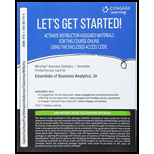
Concept explainers
a.
Find the value of
a.
Answer to Problem 19P
The value of
Explanation of Solution
Calculation:
The binomial experiment with
The probability of obtaining x successes in n independent trails of a binomial experiment is,
Where, p is the probability of success.
Substitute
Thus, the probability of zero success is 0.3487.
b.
Find the value of
b.
Answer to Problem 19P
The value of
Explanation of Solution
Calculation:
Consider
The value of
Thus, the probability of two successes is 0.1937.
c.
Find the probability of at most two successes.
c.
Answer to Problem 19P
The probability of at most two successes is 0.9298.
Explanation of Solution
Calculation:
Here,
The probability
in the binomial probability formula. That is,
Substitute the other probability values from part (a) and (b),
Thus, the probability of at most two successes is 0.9298.
d.
Find the probability of at least one success.
d.
Answer to Problem 19P
The probability of at least one success is 0.6513.
Explanation of Solution
Calculation:
Here,
Substitute the value from part (a),
Thus, the probability of at least one success is 0.6513.
e.
Find the
e.
Answer to Problem 19P
The expected value of the binomial random variable is 1.
Explanation of Solution
Calculation:
The expected value of a binomial random variable is given by,
Substitute the values
Thus, the expected value of the binomial random variable is 1.
f.
Find the variance and standard deviation.
f.
Answer to Problem 19P
The variance of the binomial random variable is 0.9.
The standard deviation of the binomial random variable is 0.95.
Explanation of Solution
Calculation:
The variance of a binomial random variable is given by,
Substituting the values
The variance of the binomial random variable is 0.9.
The standard deviation of the random variable x is obtained by taking the square root of variance.
Thus, the standard deviation of the binomial random variable is given by,
The standard deviation of the binomial random variable is 0.95.
Want to see more full solutions like this?
Chapter 5 Solutions
Mindtap Business Analytics, 1 Term (6 Months) Printed Access Card For Camm/cochran/fry/ohlmann/anderson/sweeney/williams' Essentials Of Business Analytics, 2nd
- If a binomial experiment has probability p success, then the probability of failure is ____________________. The probability of getting exactly r successes in n trials of this experiment is C(_________, _________)p (1p)arrow_forwardThe conditional probability of E given that F occurs is P(EF)=___________. So in rolling a die the conditional probability of the event E, getting a six, given that the event F, getting an even number, has occurred is P(EF)=___________.arrow_forwardThe conditional probability of E given that F occur is P(EF)= _____________. So in rolling a die the conditional probability of the event E. “getting a six,” given that the event F, “getting an even number.” has occurred is P(EF)= ____________.arrow_forward
- If a game gives payoffs of $10 and $100 with probabilities 0.9 and 0.1, respectively, then the expected value of this game is E=0.9+0.1= .arrow_forwardConsider a binomial experiment with n =10 and p = .10, then compute E(x) and Var(x).arrow_forwardConsider a binomial experiment with n = 10 and p = .10.a. Compute f(0).b. Compute f(2).c. Compute P(x ≤ 2).d. Compute P(x ≥ 1).e. Compute e(x).arrow_forward
- Consider a binomial experiment with n = 10 and p = .1a. Compute f(0).b. Compute f(2).c. Compute P(x≤2).d. Compute P(x≥1).e. Compute E(x).f. Compute Var(x) and σ.arrow_forwardConsider a binomial experiment with n = 20 and p = .70.a. Compute f(12).b. Compute f(16).c. Compute P(x ≥ 16).d. Compute P(x ≤ 15).e. Compute e(x).arrow_forwardSuppose that only 0.1% of all computers of a certain type experience CPU failure during the warranty period. Consider a sample of 4,000 computers.a. Can you use Poisson distribution as approximation for binomial? Why? b. Compute P(4<=X<=6) (Use the formula of the pmf).arrow_forward
 College AlgebraAlgebraISBN:9781305115545Author:James Stewart, Lothar Redlin, Saleem WatsonPublisher:Cengage Learning
College AlgebraAlgebraISBN:9781305115545Author:James Stewart, Lothar Redlin, Saleem WatsonPublisher:Cengage Learning Algebra and Trigonometry (MindTap Course List)AlgebraISBN:9781305071742Author:James Stewart, Lothar Redlin, Saleem WatsonPublisher:Cengage Learning
Algebra and Trigonometry (MindTap Course List)AlgebraISBN:9781305071742Author:James Stewart, Lothar Redlin, Saleem WatsonPublisher:Cengage Learning

